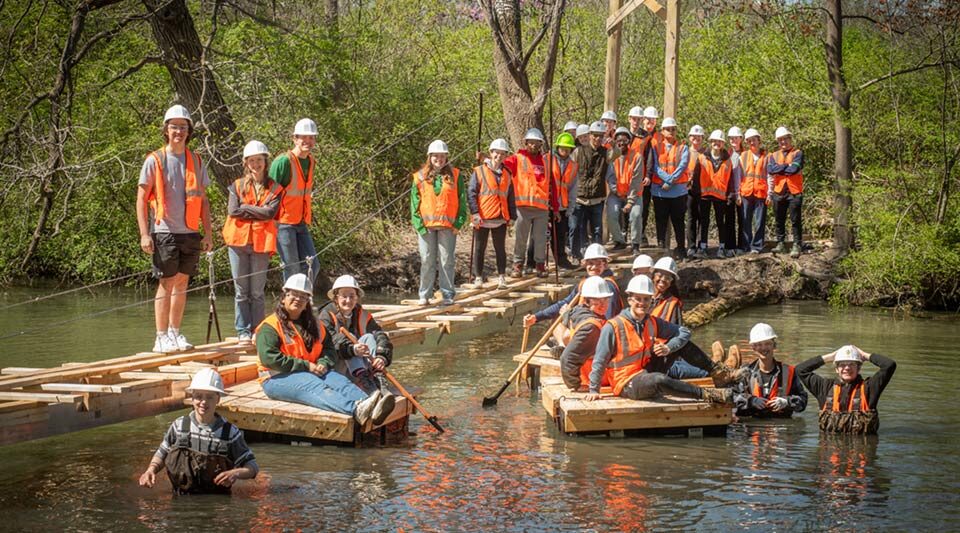As the sun rose over Notre Dame’s Golden Dome, two engineering students adjusted their hip-waders and stepped into the cold water of Saint Joseph’s Lake, pushing pontoons loaded with aluminum beams. Their classmates on land dragged cables, tested power tools, and organized decking materials. Before the sun would set that day, they would build a bridge.
Planning for the bridge began in January as part of the first-year civil engineering class, “Build, Break, Perfect.” The class is taught by Luis Fargier-Gabaldón, Massman-Beavers Associate Professor of the Practice of Heavy Civil Engineering, who has designed cantilever bridges, arch bridges, and steel bridges all over the world.
“We’re making a cable-stayed bridge this year,” said Fargier-Gabaldón. “Strictly speaking, the Brooklyn Bridge is a suspension bridge, but it has elements of cable-stayed design—cables run from the roadway to the towers to provide additional support and stability.” Similar to the truss bridge the students built last year, this year’s bridge crossed a narrow waterway between Notre Dame’s main campus and Duck Island on St. Joseph’s Lake.
Safety, surveying, and principles of structural engineering were covered before the students began designing their bridge.




Soil sampling, a skill the students learned from shared curriculum with an upper-level class on geotechnical engineering, alerted them to the soft silt and clay composing Duck Island’s soil. Extra anchors, they decided, would be needed.
Construction began on the cold, clear morning of April 19. Pontoons were key to the project. “The original purpose of the pontoons was to float the aluminum bridge components across the water,” said freshman Morgan Pietruszkiewicz. “But we were also able to use them to bring our materials back and forth and even transport people.”


Once the pontoons had floated the aluminum beams into position, the students joined them together with steel plates. Aluminum was selected for its light weight, strength and capacity to minimize vibrations—a characteristic the class measured with an app and sensors.
“We collected data on the inclination of the pier before the bridge was attached,” said freshman Claire Burke. “Then, after we’d finished construction, we monitored the bridge’s movement, with and without people walking across it.”

By noon, the aluminum beams were attached to the piers, and the cables (stays) were connected to the deck. The pontoons, which had supported the weight of the now connected beams and deck, were removed.



As the afternoon’s shadows lengthened, the cables between the bridge’s deck and towers were tightened—the bridge’s deck rose above the water. With fist bumps and music playing, the students crossed their bridge.

“Taking this class made me realize what it means to be a true engineer,” said Lea Garcia, “Our professor always emphasized the fact that engineering is not just equations and numbers. Engineering is figuring out solutions to complicated scenarios. You’ve got to plan carefully for each next step.”
— Karla Cruise, Notre Dame Engineering; photos and video by Wes Evard, Notre Dame Engineering
